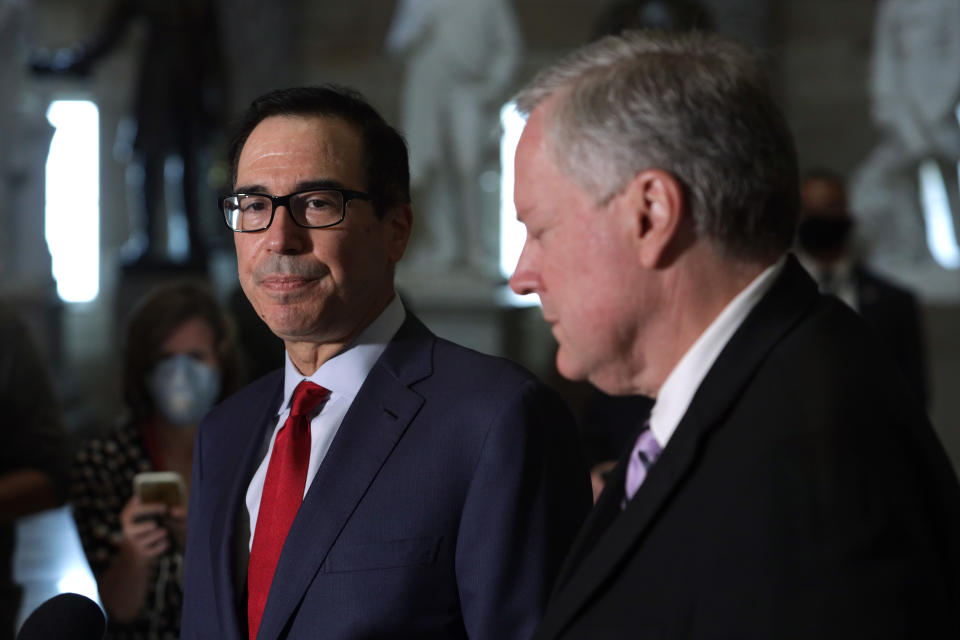Coronavirus stimulus: Wave of U.S. states run out of extra unemployment benefits as negotiations flounder
U.S. states are increasingly running out of extra unemployment benefits mandated by a presidential memorandum, and chances are fading that over 29 million jobless Americans will receive more as negotiations in Washington D.C. go nowhere.
Read more: Here’s what you need to know about unemployment benefits eligibility
Five states — Arizona, Missouri, Montana, Tennessee, and Texas — have officially exhausted six weeks worth of extra $300 weekly unemployment benefits under the Lost Wages Assistance (LWA) program. Another 19 states will likely distribute their last payments in the coming days, and the rest will pay the benefits retroactively in lump sums. (States were given the option to increase the extra weekly amount to $400 by adding $100 themselves).

“We were actually past the end of the program by a half a week before we even realized it was over,” Michele Evermore, a senior policy analyst at the National Employment Law Project, told Yahoo Money. “It just underscores how tenuous and weird this benefit actually was and it also underscores the need for actual Congressional action.”
September 5 was the last active payment day for the LWA program, which was created under an Aug. 8 executive memo n an attempt to bypass stalled negotiations with Democrats about a new stimulus bill.
“On Monday, nobody will be getting any Lost Wages Assistance [for that week],” Evermore said. “People will still get a check if they haven't been paid but they won't get a benefit that applies to this week.”
‘Come to a real agreement with Congress to continue this program’
The LWA funding is limited to up to $44 billion redirected from the Federal Emergency Management Agency (FEMA), which is why the money is running out.
The program arose after the extra $600 under the CARES Act expired, causing a sudden drop in unemployment benefits people were receiving. The ad hoc system provides funds for six weeks worth of extra $300 weekly benefits for each state that applied.

“The weakness of this program is how little money it is, how hard it will be for the state to administer it, the fact that it won't be national, and that it could become even less than what's promised,” Andrew Stettner, a senior fellow at the Century Foundation, a think tank, told Yahoo Money in August. “All these are symptoms of why it was really important to come to a real agreement with Congress to continue this program.”
Read more: Do you have to pay taxes on unemployment benefits?
The LWA program also left out close to a million low-income jobless benefits recipients since they didn’t qualify for the minimum of $100 weekly unemployment benefits.
‘Neither party is likely to fold’
After returning from recess, Republicans introduced a scaled-down stimulus proposal that included an extension of the extra unemployment benefits. The bill was rejected — as initially expected — by Senate on Thursday, and the hopes of any deal before the Nov. 3 election are fading.
“I think there's a strong possibility that they go home in October, and the long jam isn't broken,” Sarah Binder, a professor of political science at George Washington University and senior fellow at the Brookings Institute, told Yahoo Money. “Absent some feeling of being held responsible by voters for the stalemate, neither party is likely to fold.”

Binder noted that apparent disagreements between the White House and Senate Republicans remain an obstacle for any deal with Democrats.
“Part of the issue is the difficulty really knowing what the President wants,” Binder said. “He has some political support deep in the Republican party, but he doesn't have any broader political support to try to control the two parties to come to the table.”
Denitsa is a writer for Yahoo Finance and Cashay, a new personal finance website. Follow her on Twitter @denitsa_tsekova.
Read more:
New unemployment requirements make it tougher for workers to qualify
Even as GDP tanked, personal income grew thanks to government support
Read more personal finance information, news, and tips on Cashay
Follow Yahoo Finance on Twitter, Facebook, Instagram, Flipboard, SmartNews, LinkedIn, YouTube, and Reddit.

 money
money 

